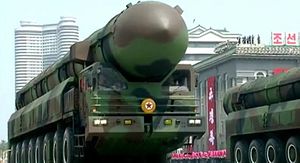On Saturday, North Korea staged a massive military parade to commemorate the 105th birth anniversary of Kim Il-sung, the country’s founder and grandfather of current leader, Kim Jong-un. The day, also known in the country as the ‘Day of the Sun,’ is the most important public holiday in North Korea. It commemorates not only the driving force behind the country’s founding, but also the patriarch of the Kim dynasty, whose personality cult rules supreme over North Korea to this day. The parade took place amid hot speculation in the United States, Japan, and South Korea that Pyongyang would look to also potentially test a sixth nuclear device, which it did not do.
Though it did not ultimately test a nuclear device on Saturday morning, what North Korea showed off at the parade should be equally concerning, even though it likely won’t be treated as such in the broader news cycle in the West. Below, I run through some of what was shown off with brief comment. In the coming days and weeks, we should see analytical deep dives into the parade footage from the community of dedicated North Korea watchers.
Keep in mind first that we’ve observed a pretty clear trend in North Korean ballistic missile testing over the past couple years. In addition to drastically increasing the frequency of its testing — North Korea has carried out 37 missile tests since the start of 2016 — Pyongyang has spent a great deal of effort toward developing survivable platforms and worked to operationalize a second-strike capability. It has additionally worked to decrease the time required for a missile launch and the satellite signature of its platforms. On top of this, North Korea has been steadily working to operationalize an intercontinental-range ballistic missile capable of striking most of the U.S. homeland.
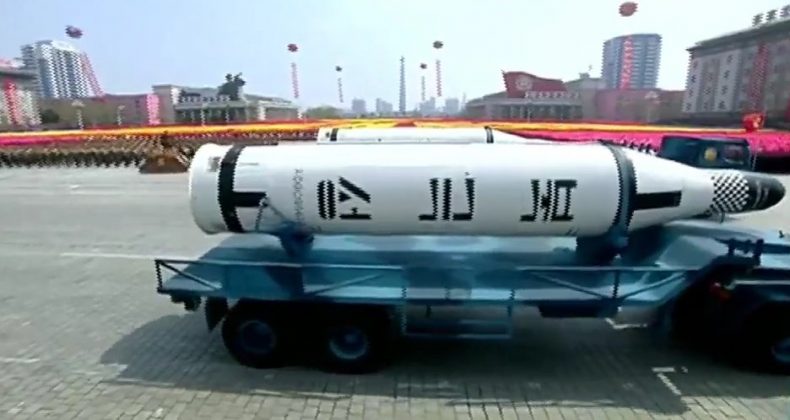
The Pukkuksong-1 submarine-launched ballistic missile on a truck. (Credit: KCTV screen capture via YouTube)
To the end of a survivable second-strike capability, we’ve seen the development and testing of the KN-11 submarine-launched ballistic missile, which has transitioned to using solid fuel propulsion and has been tested successfully in that configuration. The KN-11, intended for use aboard North Korea’s lone Gorae-class submarine, would presumably also give Pyongyang the ability to initiate a strike South Korea outside of the field of vision of the Terminal High Altitude Area Defense (THAAD) missile defense system. At Saturday’s parade, Pyongyang demonstrated that it had at least six of these missiles in its inventory. It rolled them out on trucks for display. Saturday marked the first display of the KN-11 at a parade.
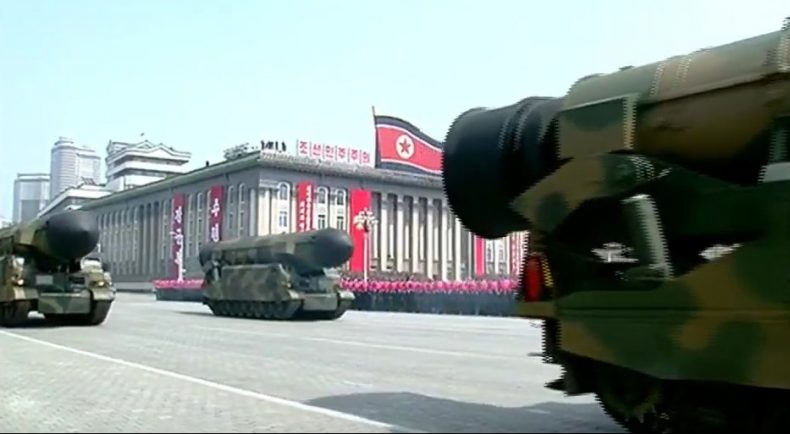
The Pukkuksong-2 TELs. (Credit: KCTV screen capture via YouTube)
Beyond the SLBM, we saw North Korea make important advances with its test of the Pukkuksong-2 (or KN-15) solid fuel ballistic missile in February this year (when Japanese Prime Minister Shinzo Abe was visiting the United States). The missile, which is a land-launched variant of the KN-11, was notable for using a tracked transporter erector launcher (TEL) and for being fully canisterized (i.e., enclosed and ready for launch). As I discussed in February, the tracked TEL is particularly a good investment for North Korea, which has a high ratio of unpaved to paved roads. North Korea has just 724 km of paved roads compared to 24,830 km of unpaved roads and regular TEL trucks cannot realistically go off-road without applying dangerous physical stress to the chassis of the missile they’d carry.
Second, the canisterization of the solid fuel missile means that North Korea would be able to store the system remotely and launch it with little warning, eliminating the sort of support vehicles that would generate a large satellite signature for the United States and South Korea to observe in a potential preemption scenario. In sum, both the KN-11 and the KN-15 are about increasing survivability and obtaining a second strike capability. North Korea showed off six KN-15 TELs at Saturday’s parade. Together, these platforms make the prospect of a preemptive strike by the United States or South Korea less palatable, leaving open the prospect of nuclear retaliation.
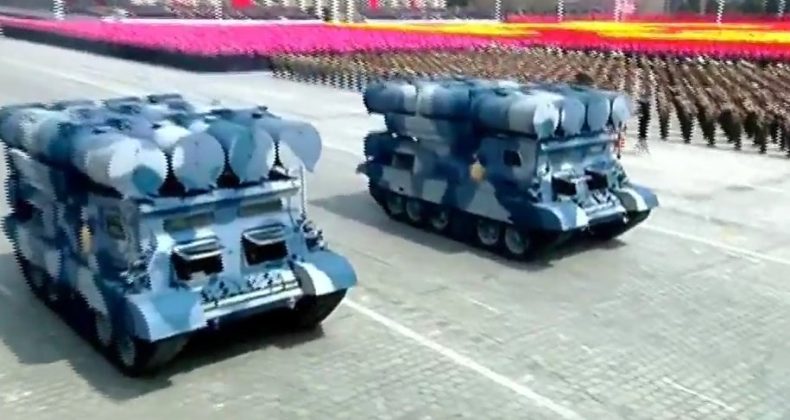
The new tracked TELs, presumably for an anti-ship missile. (Credit: KCTV screen capture via YouTube)
In addition to the KN-11 and KN-15, we saw a new type of Korean People’s Army tracked TEL carrying four smaller canisterized missiles. Though uncertain, it is likely that the new TEL is intended to launch North Korea’s non-nuclear anti-ship cruise missile, which is thought to be based off the Russian Zvezda Kh-35. The tracked TELs are again suggestive of Pyongyang envisioning their use in a versatile “shoot-and-scoot” coastal artillery scenario, where each unit would strike surface combatants at sea and move to avoid retaliation. North Korea also showed off other platforms we’ve seen before, including its SA-5 surface-to-air missile and new Multiple Launch Rocket System.
Going back to my original point — that Saturday’s display should merit attention similar to a nuclear test — the KN-11, KN-15, and possible Kh-35 variant TEL’s appearance were really the amuse bouche for North Korea watchers at the parade. North Korea saved its biggest and baddest missiles for last, as is custom at these parades. This is where things got particularly interesting, catching off-guard many North Korea experts who were watching the parade live.
First, Pyongyang showed off a Scud/Nodong-variant — again on a tracked TEL — with fins on the nose cone. I’ve gone into why the tracked TEL is significant above; similar reasoning applies with this launcher, especially as Pyongyang has shown an interest in salvo-launching Scuds and Nodongs in a possible first strike scenario. The fins on the nose cone may have been mocked up for the parade, but are suggestive of North Korea possibly looking into maneuverable reentry vehicle technology, which could presumably make these missiles more difficult to intercept. From the parade footage alone, it may be unfeasible to glean more about just how significant these changes may be. North Korea also showed off its intermediate-range Hwasong-10 (Musudan) missile, the much-ballyhooed ‘Guam-killer’; that missile saw frenzied testing last year, with at least six confirmed tests (five failed, one succeeded in June 2016).
Second, we saw a larger missile, possibly a variant of the long-discussed KN-08 or KN-14 intercontinental ballistic missile (both theoretically capable of reaching most of the U.S. homeland with a reasonable payload). This missile, which remains untested to this day, was shown off with a new color scheme like the Musudan and, oddly enough, on board a TEL truck that appeared almost identical to the Musudan’s. It’s unclear if North Korea may have attempted to test this KN-08/KN-14 variant at some point — possibly late last year at Kusong, when U.S. and South Korean monitoring picked up two failed tests that exploded shortly after launch.
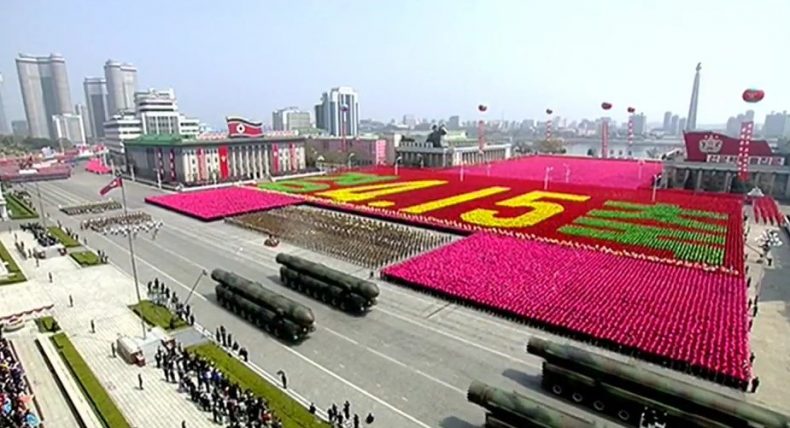
Birds-eye view of the new canisterized TELs that could presumably accommodate an ICBM. (Credit: KCTV screen capture via YouTube)
After the new KN-08/KN-14 had strolled out of the limelight in Pyongyang’s Kim Il-sung square, North Korea introduced the crescendo of the whole affair: it rolled out two previously unseen ICBM-sized canisters on board massive TELs. One TEL appeared to be similar to an older KN-08 TEL and the other appeared to be new (though similar in appearance to a Chinese DF-41 or Russian Topol-M). We don’t know what — if anything — was inside the canisters since North Korea hasn’t publicly shown off or tested any missile of that size before. However, we can infer given the size of the canister and the fact that it was paraded on Saturday that Pyongyang wants the world to know that it is actively working toward at least two types of solid-fuel, canisterized ICBMs (possibly with three stages).
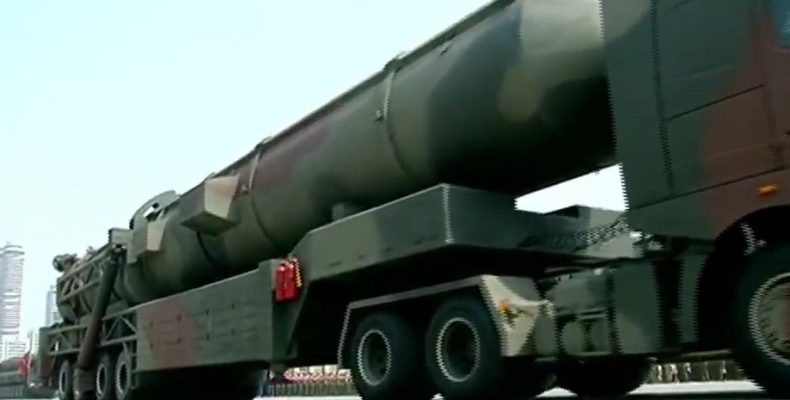
One of the new unidentified ICBM-sized canisterized TELs. (Credit: KCTV screen capture via YouTube)
That’s a development that should merit quite a bit of attention. Even if it’s unlikely that North Korea is close to that capability today, they’ve already shown their work toward various components of making such as a system work. For instance, we see in video footage released by North Korea after the February 2017 KN-15 launch that the hydraulics involved in the canister’s cold launch system ejected the missile — which is relatively short compared to the canisters seen on the new TELs — over twice its length, suggesting that Pyongyang may already be capable of ejecting heavier ICBMs. Second, as I’ve discussed before, North Korea is very serious about its work on high-thrust engines for use on an ICBM. It may choose to carry out an initial test using a non-canisterized KN-08 or KN-14, but these new TELs are still cause for concern.
In summation, as I noted on Twitter during the parade, the two big technical trends this year for North Korea may be tracked TELs and canisterized systems. More broadly, observing the parade took left me reflecting on the somewhat grim prediction I’d made in January that 2017 would turn out to be the year of the North Korean ICBM. Given both what North Korea has said and now what it has shown, this certainly seems to be the case. And more so than ever, North Korea seems to be highlighting the perils of a preemptive first strike to the United States and South Korea. With every nuclear and ballistic missile test, its threat of inflicting unacceptable retaliatory damage against Seoul and, eventually, Washington becomes more credible.
What’s more, we’re likely still in for a sixth nuclear test sooner or later. Even though Pyongyang withheld from testing this weekend amid rumors of possible retaliation by the United States, North Korea is still looking to improve its missile know-how. Moreover, the long-dreaded ICBM flight test also might not be too far off now. Given the ever-growing number of TELs — both wheeled and tracked — North Korea may soon field nuclear forces amply large that a conventional U.S.-South Korea first strike may find it impossible to fully disarm Pyongyang of a nuclear retaliatory capability. That would give the North Korean regime what it’s always sought with its nuclear and ballistic missile program: an absolute guarantee against coercive removal.
Editor’s Note: The April 2017 issue of The Diplomat‘s magazine features a deep dive by John Schilling into North Korea’s strategic missile capabilities. That article is accessible here.













